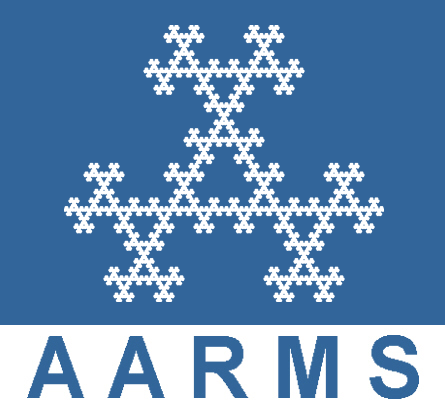Réunion d'hiver SMC 2016
Niagara Falls, 2 - 5 décembre 2016
Org: Pietro-Luciano Buono (University of Ontario Institute of Technology) et Victor LeBlanc (University of Ottawa)
[PDF]
- JASON BRAMBURGER, University of Ottawa
Spiral wave solutions to lambda-omega lattice dynamical systems [PDF]
-
In this talk we inspect an infinite system of coupled lambda-omega differential equations indexed by the two-dimensional integer lattice and show there exists a spiral wave solution. It is demonstrated that the infinite-dimensionality of the system poses unique problems in that traditional techniques from systems of finitely many differential equations cannot be directly applied. In particular, the existence proof requires extensive results from Banach space theory and a "Hard" Implicit Function Theorem. Some brief remarks on the history and relevance of lambda-omega systems are also provided to properly frame the results.
- LAURENT CHARETTE, University of British Columbia
Pattern Formation on a Time Dependent Spherical Cap [PDF]
-
We try to extend the theory of diffusely-driven patterns on a spherical cap surface by introducing a domain that is slowly dependent on time. The domain evolution preserves the base of the cap, but slowly changes its curvature. The goal of the project is to try to extend the normal form theory for this slow domain evolution using asymptotic expansions on series of eigenfunctions of the Laplace-Beltrami operator, so we can approximately predict how patterns emerge in this case using only non-autonomous ordinary differential equations.
This is work that is currently in progress with Wayne Nagata, so the contents of the talk are currently unknown, but it will probably include a quick overview of the results in the static domain, the extension of the partial differential equation to accommodate for domain evolution, some details on the ODE reduction and possibly some numerical results.
- YANXIA DENG, Queen's University
Conley-Zehnder index and bifurcation of fixed points of Hamiltonian maps. [PDF]
-
We study the bifurcations of fixed points of Hamiltonian maps and symplectic diffeomorphisms. We are particularly interested in the bifurcations where the Conley-Zehnder index of a fixed point changes. The main result is that when the Conley-Zehnder index of a fixed point increases (or decreases) by one or two, there are several bifurcation scenarios. Under some non-degeneracy conditions on the one-parameter family of Hamiltonian maps, two, four or eight fixed points bifurcate from the original one. We give a relatively detailed analysis of the bifurcation in the two dimensional case. Higher dimensional cases can be reduced to the two dimensional case.
- FLORIN DIACU, University of Victoria
Bifurcations in the N-body problem when the space curvature varies [PDF]
-
We consider the classical N-body problem in spaces of constant curvature k, namely 3-spheres, hyperbolic 3-spheres, and the Euclidean space. Our equations of motion recover the Newtonian case when k=0. We show how the integrals of motion bifurcate when k varies and then focus on the 3-body case to study the bifurcation of triangular solutions.
- NICHOLAS FAULKNER, University of Ontario Institute of Technology
Equivariant KAM Theorem [PDF]
-
Kolmogorov-Arnold-Moser (KAM) theory has a rich and well developed history. In this talk we present a KAM theory for $\Gamma$-equivariant Hamiltonian systems. Hamiltonian systems with discrete symmetry groups $\Gamma$ arise naturally in many settings including for instances the $N$-body problem. If $\Gamma$ is Abelian, then KAM theorem applies, but for $\Gamma$ non-Abelian, $1 : 1$ resonance effects lead to small divisor problems. These problems can be overcome by combining the isotypic decomposition of phase space with a detailed study of $\Gamma$ and Torus invariants, all within the classical iterative proof structure. This is joint work with Dr. Luciano Buono.
- PETKO KITANOV, University of Ottawa
Dynamics of meandering spiral waves with weak lattice perturbations [PDF]
-
\title{Dynamics of meandering spiral waves with weak lattice perturbations}
\author{Petko M. Kitanov and Victor G. LeBlanc}
Spiral waves are observed in many different situations in nature, perhaps most importantly in excitable electrophysiological tissue where they are believed to be responsible for pathological conditions such as cardiac arrhythmias, epileptic seizures and hallucinations. Mathematically, spiral waves occur as solutions to systems of reaction-diffusion partial differential equations which are frequently used as models for electrophysiological phenomena. These equations are invariant with respect to the Euclidean group $SE(2)$ of planar translations and rotations. In reality however, Euclidean symmetry is at best an approximation. Inhomogeneities and anisotropy in the medium of propagation of the waves break the Euclidean symmetry, and can lead to such phenomena as anchoring and drifting. In this paper, we study the effects on quasi-periodic meandering spiral waves of a small perturbation which breaks the continuous $SE(2)$ symmetry, but preserves the symmetry of a regular square lattice. Our main results are on the effects of lattice symmetry-breaking on respectively quasi-periodic meandering waves, on meandering waves whose meander path is a closed epicycle (we pay special attention to phase-locking in this case), and on modulated travelling waves. In each of these cases, we give the main mathematical results, give an interpretation for how these mathematical results translate to dynamical features of spiral waves, and then illustrate with numerical results performed on FitzHugh-Nagumo system for various choices of inhomogeneity functions, and various kinematic parameters.
- DMITRY PELINOVSKY, McMaster University
Bifurcations of self-similar solutions in slow diffusion equations [PDF]
-
We consider the slow nonlinear diffusion equation subject to a strong absorption rate and construct local self-similar solutions for reversing (and anti-reversing) interfaces, where an initially advancing (receding) interface gives way to a receding (advancing) one. We use an approach based on invariant manifolds, which allows us to determine the required asymptotic behaviour for small and large values of the concentration. We then `connect' the requisite asymptotic behaviours using a robust and accurate numerical scheme. We show that the self-similar solutions bifurcate from the time-independent solutions for standing interfaces. Such bifurcations occur when the confluent hypergeometric functions satisfying Kummer's differential equation is truncated into a finite polynomial. This condition specifies a countable set of admissible values for the parameters
of slow diffusion and strong absorption. A two-scale asymptotic procedure allows us to deduce the asymptotic dependencies of the self-similar reversing interfaces near the bifurcation points. The asymptotic results are shown to be in excellent agreement with numerical computations.
- MANUELE SANTOPRETE, Wilfrid Laurier University
Canonoid and Poissonoid Transformations, Symmetries and bi-Hamiltonian structures. [PDF]
-
Symplectic transformations between symplectic manifold are maps that
preserve the symplectic structure. Such maps transform any
Hamiltonian system on the first symplectic manifold to a Hamiltonian
system on the second symplectic manifold. Canonoid transformations
are a generalization of symplectic transformation. They transform a
given Hamiltonian system defined on a symplectic manifold to another
Hamiltonian system. The term ``canonoid" was introduced by Saletan and
Cromer in 1971. A modern coordinate-free definition was given by Marmo
in 1976. In this talk we will give an introduction to canonoid
transformations. Then we will generalize such transformations to the
Poisson case, introducing ``Poissonoid transformations". We will give
a brief introduction to bi-Hamiltonian systems, an important type of
integrable systems. We will show that Poissonoid transformations may
be useful to obtain bi-Hamiltonian structures in certain examples
(e.g. the rigid body, the multidimensional rigid body, and Kirchhoff'e
equations for a rigid body in a fluid).





